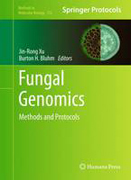
Having experienced unprecedented growth since the turn of the millennium, thedramatic expansion of resources and techniques in fungal genomics is poised to fundamentally redefine the study of fungal biology. In Fungal Genomics: Methods and Protocols , expert researchers explore the three most likely fronts upon which the field will advance: the sequencing of more and more fungal genomes, the mining of sequenced genomes for useful information, and most importantly, the use of genomics sequences to provide a foundation for powerful techniques to explain biological processes. Much of the book is dedicated to explaining established and emerging genomics-based technologies in filamentous fungi,including gene expression profiling techniques, techniques for fungal proteomics as well as various case studies that could be adapted to a wide range of fungi. Written in the highly successful Methods in Molecular Biology™ series format, protocol chapters include brief introductions to their respective topics, lists of the necessary materials and reagents, step-by-step laboratory protocols, and key unpublished tips, potential pitfalls, common mistakes, and special considerations based on the unique experiences of the contributors. Authoritative and cutting-edge, Fungal Genomics: Methods and Protocols provides fungal biologists at any stage of their careers a user-friendly resource for fungal genomics, especially as readers branch out into unfamiliar but exciting new areas of study. Emphasizes unpublished tips, potential pitfalls, common mistakes, and special considerations directly from the experts. Supports readers with the key information needed to keep up with and excel in this steadily progressing field.Features practical protocols, ready for implementation in the lab. INDICE: Genome Sequencing and Assembly. Targeted Cloning of Fungal Telomeres. Identification and Annotation of Repetitive Sequences in Fungal Genomes. Next-Generation Sequencing and Potential Applications in Fungal Genomics. Getting the Most Out of Your Fungal Microarray Data: Two Cost and Time-Effective Methods. Fusarium graminearum from Expression Analysis to Functional Assays. ESTAnalysis Pipeline: Use of Distributed Computing Resources. The Application ofChIP-chip Analysis in the Rice Blast Pathogen. Proteome Studies of Filamentous Fungi. A Bioinformatics Pipeline for Sequence-Based Analyses of Fungal Biodiversity. Identifying Protein Complexes by Affinity Purification and Mass Spectrometry Analysis in the Rice Blast Fungus. Large Scale Identification of GenesInvolved in Plant-Fungal Interactions Using Illumina’s Sequencing-By-Synthesis Technology. High-Throughput Production of Gene Replacement Mutants in Neurospora crassa. Phenotypic Analysis of Neurospora crassa Gene Deletion Strains. Efficient Approaches for Generating GFP Fusion and Epitope-Tagging Constructs in Filamentous Fungi. Large Scale Insertional Mutagenesis in Magnaporthe oryzaeby Agrobacterium tumefaciens -Mediated Transformation. Molecular Methods for Studying the Cryphonectria parasitica – Hypovirus Experimental System. Metabolic Fingerprinting in Fusarium verticillioides to Determine Gene Function. Tapping Genomics to Unravel Ectomycorrhizal Symbiosis.
- ISBN: 978-1-61779-039-3
- Editorial: Humana Press
- Encuadernacion: Cartoné
- Páginas: 285
- Fecha Publicación: 17/05/2011
- Nº Volúmenes: 1
- Idioma: Inglés
